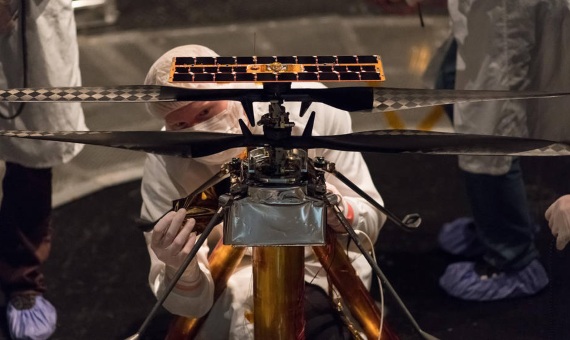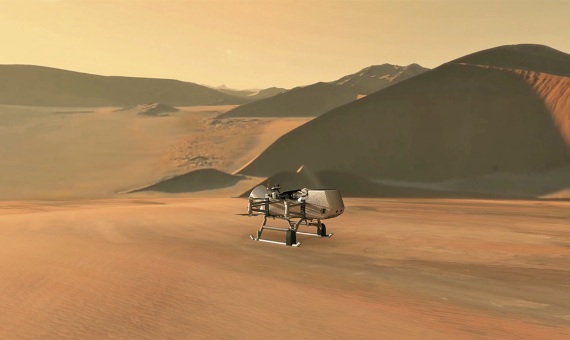In February 2021, if everything goes as planned, NASA will put a new rover on the red planet with the Mars 2020 mission. It will be a vehicle similar to its predecessor Curiosity, but this time will carry a travel companion, a tiny autonomous helicopter that will travel to Mars attached to the underside of the rover, almost like a space stowaway.
Known simply as Mars Helicopter, the drone will be deposited onto the Martian soil a few months after the arrival of the rover, in order to carry out a series of test flights. It will be a small step for robots (which have been exploring the Solar System for decades), but a giant leap for drones: if successful, it will mark the first time that humanity will fly a device on another planet.
Mars Helicopter weighs just 1.8 kilos and has all the necessary equipment to fly independently. It consists of a body the size of a handball with small legs. Inside the body are navigation and communications instruments, batteries, motors and a heating system to protect the equipment from the cold. On the body there are two counter-rotating blades located in the same axis —each one 1.2 metres from tip to tip— and at the end of this axis a solar panel. The drone also has a camera that will take pictures of the surface.
The large size of the rotary blades —much larger than the body— respond to the need to create sufficient lift in the Martian atmosphere, one hundred times thinner than the terrestrial atmosphere at sea level. To do this, the blades must rotate at about 2,400 revolutions per minute, ten times faster than the flight of a similar aircraft on Earth would require. The lower Martian gravity, a third that of Earth’s, works in favour of the engineers on this occasion.

Mars Helicopter is expected to perform a series of 90-second flights, during which it could reach a maximum of five metres in height. After successfully completing each flight it will recharge its batteries using the solar panel. After the first flight, NASA will analyse the images to find a safe place for the next landing, although the drone must remain close to the rover, which acts as a communications link to Earth. The main objective of the Martian helicopter is to demonstrate that it is possible to fly on Mars, test the technology and gather information for the design of future more advanced and reliable drones. For this reason, its designers have not bothered to include any kind of scientific instrumentation.
An unprecedented viewpoint
On Earth, flying drones are already a proven and reliable technology. Their adaptation for space exploration may be revolutionary. “There are places where it’s just not practical or even possible for rovers or humans to go, but helicopters are much more mobile in that sense and could potentially go to places that could otherwise be inaccessible,” explained Havard Grip, the engineer in charge of the flight systems of Mars Helicopter during the mission presentation last March. “We envision a helicopter potentially acting as a scout or reconnaissance platform for a future rover. Later, Grip said, more advanced versions of them could serve as support for manned missions to Mars, where astronauts would use them to learn about the surrounding terrain.
What’s clear is that these vehicles would allow an unprecedented view of the Martian surface and a much more dynamic exploration of it. “Currently, we have exploration capabilities on Mars that include orbiters that can take large aerial imagery from high altitudes of the Martian surface and we have stationary landers and rovers that also take pictures of the surface,” Grip said. “What we can do with helicopters is get up to a high vantage point and traverse relatively unhindered by the terrain and still get detailed images of the surface, so it’s bringing an aerial dimension that is currently missing from our exploration capabilities.”
Mars Helicopter will be a first step in measuring the capacity of drones in space exploration, a test that will pave the way for other more ambitious plans that NASA already has in place. In June 2019, the agency chose the Dragonfly mission as the next step in its New Frontiers exploration program, which will send a dragonfly-shaped drone to Titan, Saturn’s largest moon.
Some scientists believe Titan can answer many questions about the origin of life on Earth. Although temperatures hover around 180 degrees below zero, so cold that methane is liquid on its surface, this satellite of Saturn has an atmosphere with abundant nitrogen and a hydrological cycle similar to that of Earth (switching water for methane). “Titan is such an amazing, complex destination,” said Elizabeth Turtle, principal investigator at Dragonfly, on the occasion of the selection of the mission last June. “We don’t know the steps that were taken on Earth to get from chemistry to biology, but we do know that a lot of that prebiotic chemistry is actually happening on Titan today.”
Beyond Mars
With a launch date scheduled for 2026 and a cost of 1 billion dollars (900 million euros), Dragonfly will be a very different machine from the small Martian helicopter. About three metres long, it will have eight rotors arranged in four axes and will be able to sustain itself for longer in the atmosphere of Titan, whose density is double that of the Earth. It will be equipped with a nuclear generator powered by plutonium to produce energy and recharge its batteries. It will also carry numerous scientific instruments to study Titan’s complex organic chemistry.

Differences aside, both devices have mobility as a common element. “It’s remarkable to think of this rotorcraft flying miles and miles across the organic sand dunes of Saturn’s largest moon, exploring the processes that shape this extraordinary environment,” Thomas Zurbuchen, one of NASA’s top administrators in Washington, said after the presentation of the mission.
The use of drones as extraterrestrial exploration vehicles opens the door to a new era for space missions. If Mars Helicopter functions as expected and succeeds in making the first flight on another planet, everything will be ready for Dragonfly to travel hundreds of kilometres through the skies of distant Titan during its two-and-a-half-year mission. If the rhythm of the discoveries increases as much as the speed of the vehicles, comparing them to the snail’s pace of the rovers that have explored Mars or the Moon, a true revolution awaits us.
Comments on this publication